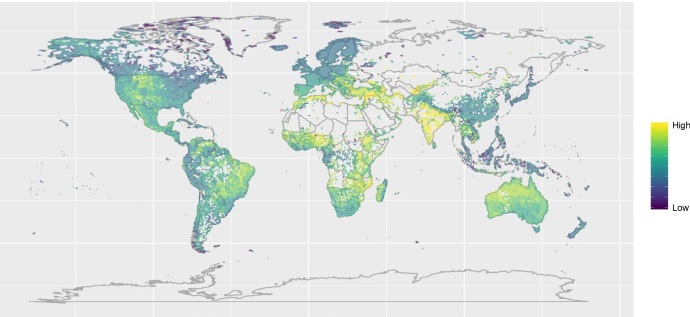autor Anton Zolotarjov
autor Anton Zolotarjov
autor Linda-Liisa Veromann-Jürgenson
autor Kersti Püssa
autor Anton Zolotarjov
autor Anton Zolotarjov
autor Linda-Liisa Veromann-Jürgenson
autor Kersti Püssa
It´s really a very simple paper! A (relatively little) database containing information about all the plants (on genus level) that fix nitrogen from the soil. Somehow this information has not been available so far in a comparable and trustworthy way. Plus, it´s readily accessible – in a form or Excel table.
Together with some additional taxonomic information for both plant and bacterial taxa, estimation of consensus, comparison with other sources that have tackled the same topic. To an ecologist, especially macroecologist, this dataset is a great source for easily getting potentially crucial trait added to your dataset. Because, as you can see from the GBIF-data based analysis (see the graph below), the proportion of N-fixing plants can differ quite a lot on global scale.
Citation: Tedersoo, L., Laanisto, L., Rahimlou, S., Toussaint, A., Hallikma, T., & Pärtel, M. (2018). Global database of plants with root‐symbiotic nitrogen fixation: Nod DB. Journal of Vegetation Science, doi.org/10.1111/jvs.12627 (link to full text)

Figure 2 from the paper: Species richness of N-fixing vascular plants relative to total species richness as based on all GBIF vascular plant records with coordinates. Relative richness is calculated per equal area polygons (ISEA3H) with size ca 7,000 km2. Colours show quantiles. Only terrestrial polygons hosting more than 50 records are shown.
Abstract:
Plants associated with symbiotic N‐fixing bacteria play important roles in early successional, riparian and semi‐dry ecosystems. These so‐called N‐fixing plants are widely used for reclamation of disturbed vegetation and improvement of soil fertility in agroforestry. Yet, available information about plants that are capable of establishing nodulation is fragmented and somewhat outdated. This article introduces the NodDB database of N‐fixing plants based on morphological and phylogenetic evidence (available at https://doi.org/10.15156/bio/587469) and discusses plant groups with conflicting reports and interpretation, such as certain legume clades and the Zygophyllaceae family. During angiosperm evolution, N‐fixing plants became common in the fabid rather than in the ‘nitrogen‐fixing’ clade. The global GBIF plant species distribution data indicated that N‐fixing plants tend to be relatively more diverse in savanna and semi‐desert biomes. The compiled and re‐interpreted information about N‐fixing plants enables accurate analyses of biogeography and community ecology of biological N fixation.